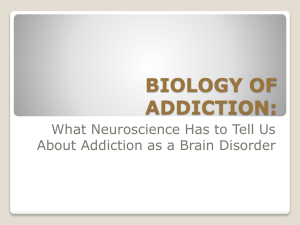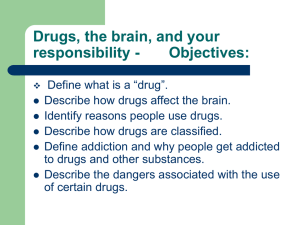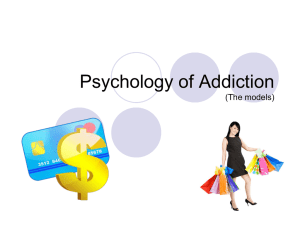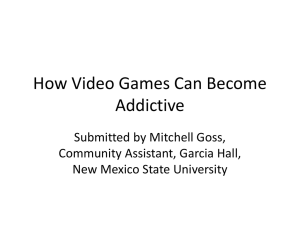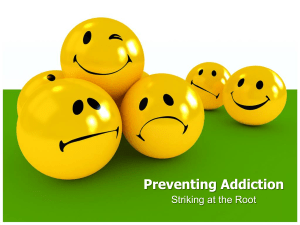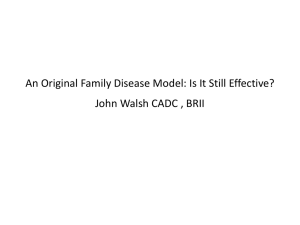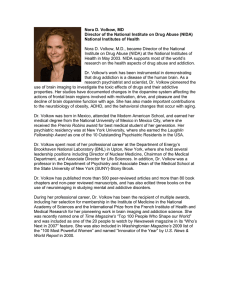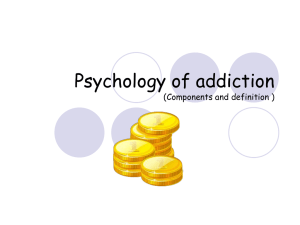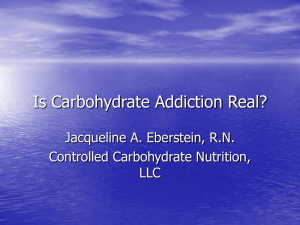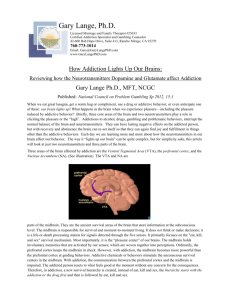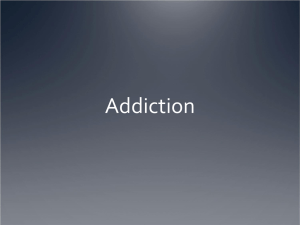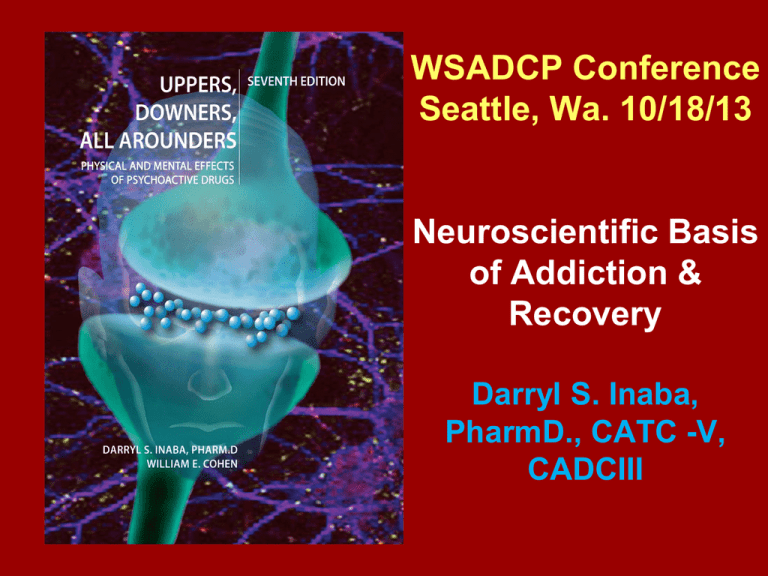
WSADCP Conference
Seattle, Wa. 10/18/13
Neuroscientific Basis
of Addiction &
Recovery
Darryl S. Inaba,
PharmD., CATC -V,
CADCIII
Neuroscience of Addiction &
Recovery Continues
2 Stops Remaining
• 1:15 pm Roots of Addiction
• 2:45 pm Current Trends in
Substance Abuse
Part III: Roots of Addiction: Etiology of
Substance-Related & Addictive Disorders
1:15 - 2:30pm with Break 2:30 - 4:00pm
Darryl S. Inaba, PharmD., CATD V, CADC III
Director of: Clinical and Behavioral Health Services - Addictions Recovery Center
Research and Education - CNS Productions, Inc. Medford, Oregon
Multiple Theories & Beliefs
About the Cause of Addiction
• Right Brain Predominance/Lateral Shift
Impairment
i.e. Dr. Evelyn Virshup
• Non-Fixed Allergic Response i.e. Dr. Linus Pauling
• Mosaic: Genetic, Stimulus Augmentation
and Poor Bonding to Same Sex Parent
i.e. Dr. Stan Gitlow
• Family & Environmental Dynamics i.e. Drs. Jessor
• Developmental Dynamics
i.e. Dr. Steven Glenn
• Protective and Resiliency Factors
i.e. Dr. Mervlyn Kitashima
• Behavioral via Social/Environmental
Influences
i.e. Stanton Peele
• Isms, Biases, Exclusion
i.e. Phil Diaz
• Genetic Predisposition
i.e. Drs. Blum & Noble
• Neurochemical Imbalance i.e. Drs. Synder & Pert
• Spiritual Aberration i.e. Fathers Leo Booth & Joseph Martin
• Conditioning
i.e. Alfred Lindesmith
• Pathologic Belief System i.e. Drs. Weiss & O’Connor
• Neuronal Dysfunction
i.e. Drs. Childress & London
Diathesis-Stress Model of
Addiction & Related Disorders
• HEREDITY – Type I
• ENVIRONMENTAL – Type II
Stress (esp. Trauma) & Poor Nutrition
• PSYCHOACTIVE DRUG TOXICITY –
Type III
Note: each phenotype has to have
elements of the others to be activated
Type I: Heredity
[Pioneering Research by Aristotle, D. Goodwin 1976,
M. Schuckit 1986, K. Blum, E. Noble et al. 1990]
Most Project 40 - 60%
Contribution to Addiction
•
•
•
•
•
•
•
•
•
•
•
CREB
CHRM2
GABRA2
Leu-Pro allele
NQD2
ADH4
KMALDH1
COMTmet158met
DRD2A1 Allele
Tipsy Gene: CYP2E1
AUTS2
•
•
•
•
•
•
•
•
•
•
GABRG3
TAS2R16
SNCA
OPRK1
PDYN
CYP2D6
CHRNA4
DeltaFosB
Novelty Gene: DRD4
Finnish Rage/Alcohol
Gene: HTR2B
89 genes associated & > 900 suspected
DRD2A1 is found in
20% of non-addicted people
30% of social drinkers
70% of severe alcoholics
DRD2A1 is also found in:
• 45% of compulsive overeaters
• 48% of smokers
• 52% of cocaine addicts
• 51% of pathological gamblers
• 76% of pathological gamblers with drug
problems
• 33% of US population have a DRD2A1 gene
Dr. Kenneth Blum UT Austin now
focusing on 9 Genes & 10 Alleles
• MAOA
• 5HTTLP
• SLC6A3 & SLC6A4
• DRD4
• DRD2
• COMT
• GABRG2, GABRA2 & GABRA6
These determine his Genetic Addiction Risk
Score (GARS)
Nicotine & Major Depression
linked to 3p26-3p25 Gene
Pergadia, ML, et al 2011
Type II: Environment: Stress
& Nutrition
Type III: Toxicology:
Neurochemical &
Neurofunctional Allostasis
Type II: Environment
• Early Childhood Trauma (physical, sexual,
emotional abuse, tragic event, grief,
anything that is traumatic to an individual)
• Stress including Mental Health Disorders
• Nutritional Deprivation and Imbalances
All recently associated with epigenetic changes
resulting in different expression of dominant and
recessive traits or turning on or off of genes
Major Traumatic Event:
Impact on the Brain
• 50% of U.S. population experiences at least
one major traumatic event in their life, 75% of
behavioral health workers and 90% of
behavioral health patients
• Trauma changes structure and chemistry of the
brain making one more susceptible to
addictions and mental health disorders
• Increased vulnerability partly due to Epigenetic
Expressions that result from trauma (stress) ,
toxins, diet and even behaviors
Trauma & Adverse Childhood
Experiences (ACE)
Experience of Violence & Victimization
(sexual/physical abuse, severe neglect,
loss, domestic violence and/or witnessing
of violence, terrorism or disasters)
National Association of State Mental Health Program Directors 2006
Childhood trauma shapes a child’s beliefs
about their identity, world view and even
their spirituality
Prevalence and Impact on
Addictions
• 61% of men 51% of women in US have
experience at least 1 traumatic event
Kessler et al., 1995
• 90% of Behavioral Health consumers have
experienced at least 1 ACE and most have
multiple ACE in their lifetimes
Mueser et al., 2004
• 66.7% of men and women in treatment for
addiction report childhood abuse & neglect
SAMHSA, CSAT, 2000
Epigenetic Expression
Chromosome
Chromatin fiber
Histones
protein
DNA wound on
Nucleosomes like
‘beads on a string’
DNA Double helix
Methylation, Acetylation, Phosphorylation of genetic peptide and
5hmC tags result in altered expression of genes
Epigenetic Expression
Identical Twin Mice with Divergent
Epigenetic Expression
Even Identical Twin with
Epigenetic Expression of
Different Races
MAOA Gene Expression, Childhood
Trauma and Antisocial Behavior
MAOA gene related to improved
Neural transmission in the brain
Type III: Neurotransmitters
Homeostasis/Allostasis
Tolerance, Tissue Dependence,
up/down regulation, enzyme
induction, auto receptors, drug
dispositional, pharmacodynamics,
altered transporter mechanisms,
epigenetic expressions, et al.
Psychoactive Drugs Affect
Perception, Mood, and States of
Consciousness by mimicking or
Disrupting the Natural
Chemistry of the Brain
Expanded Definition = Any Behaviors (e.g.
Gambling) that Alter Moods and Affect the
Brain’s Addiction Circuitries and Pathways
Drugs Mimic, Disrupt, or
Block Neurotransmitters
SOME EXAMPLES UPPERS: Catecholamines (Norepinephrine,
Epinephrine, Dopamine) + Serotonin and
Acetylcholine
DOWNERS: Endorphin, Enkephalin, GABA,
Serotonin
PSYCHEDELICS: Serotonin, Acetylcholine,
Alpha Psychosin, Norepinephrine, Dopamine,
Anandamide & endocannabinoids
Neurotransmitters
Acetylcholine
Norepinephrine
Epinephrine
Dopamine
Endorphin
Enkephalin
Serotonin (5HT)
GABA
Substance “P”
Anandamide
Glycine
Histamine
Nitric oxide
Glutamic acid
Cortisone
Aspartic Acid
© 2007, CNS Productions, Inc.
All Addictive Substance Involve
Dopamine Activity
2012 UCSF Research Confirms Role of Endogenous Opioid
Neurotransmitters in Reward Circuitry as well as Dopamine
Beta Endorphin
Met-Enkephalin
Also Excess Nor Epinephrine (Nor Adrenaline)
and Less Transporters in Pathological Gamblers
Expanding Role of GABA &
Glutamate
Inhibitory
Excitatory
Serotonin aka 5-hydroxytryptamine
also involved with all addictions?
All addictive drugs and behaviors
force brain cells to adapt and
adjust to what it views as an imbalance of its own neurotransmitters thus resulting in an allostasis
that requires continued drug use
or addictive behaviors to maintain
its functioning even though it is an
imbalanced abnormal functioning
Neuron Homeostasis: Brain in Dynamic
Equilibrium
Secondary Terminal
Axon Terminal
Auto Receptors on Axon
Synaptic Vesicles
Neurotransmitters
Axonal Transport
Dendrite Receptors
Dendrite
Brain on
Cocaine
Minutes
after
shooting
or
smoking
Courtesy of
Nora Volkow, Ph.D.
Normal
Normal
Normal
CourtesyCourtesy
of Volkow,ofWang,
& Begleiter,
al.)
Volkow,
Wang, &etBegleiter,
et al.)
Normal
Dopamine Depletion in Addiction =
Endogenous Craving and Anhedonia
Nicotine Evokes Addictive Brain
Changes With Just One Puff
Courtesy of Daniel Amen, M.D.
Marijuana Abuse
Courtesy of Daniel Amen, M.D.
Diathesis-Stress Model of
Addiction & Related Disorders
• HEREDITY – Type I
• ENVIRONMENTAL – Type II
Stress (esp. Trauma) & Poor Nutrition
• PSYCHOACTIVE DRUG TOXICITY –
Type III
Note: each phenotype has to have
elements of the others to be activated
Hereditary hater of alcohol
Hereditary lover of alcohol
Alcoholic mouse
DBA/2j = Genetic alcohol/Drug avoiding mice
C57bl/6j = Genetic alcohol/drug loving mice
DBA/2J
C57bL/6J
Conclusion – Questions?
Understanding:
Addiction is a set of
biologic & psychological
anomalies in neurocellular,
neuro-chemical, and neurofunctioning of vulnerable
Individuals that result from
a combination of Genetic,
Environmental and Toxicological influences.
Conclusion
•
Addiction is not about morals, will power
or character. It’s about anomalous
neurocellular, neurochemical and
neurofunctional features of vulnerable brains
that hijacks their reward and control circuits
resulting in behaviors that are defined as
Addiction.
• Good news is that the brain is resilient, it’s
plastic, it has the ability to bring itself back to
healthy functionality if given the chance to.
Treatment Works!
•
•
•
•
•
•
3 to 5 Yrs. Continued sobriety = 50% (1yr 80%)
Decrease Crime = 75%
$7-$12 Savings for every $1 Spent
Positive results from 6-8 mo. Treatment
Coerced treatment better than voluntary
Decreased Psychiatric (40%),
Family/Social (50-60%), Medical (15-20%),
Employment Problems (15-20%)
• Culturally consistent better than generic
treatments
Belenko, et al. 2005
Courtesy of Nora Volkow, et al. Journal of Neuroscience, 21, 9414-9418, 2001
Thank You!
Darryl Inaba,
PharmD., CATC V,
CADC III
Disclosures: Dominion
Diagnostics
North Kingstown, RI;
CNS Productions
Medford, OR; J. of
Psychoactive Drugs,
San Francisco, CA
Break Time




